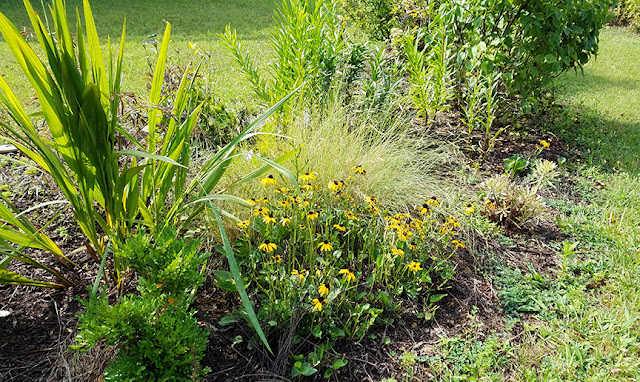 |
| Box turtle browsing on woolly thyme. |
 |
| Box Turtle in front yard. |
Lately I've been finding new creatures in my garden. A few days ago it was a box turtle in our front yard. Herb had told me that several days before, he'd seen a box turtle in the middle of the street, just around the corner from our house, and fearing that the turtle would get run over by a car, he stopped and very carefully picked it up to move it to one side, depositing it on the lawn in front of a neighbor's house.
Now, we few days later, a box turtle shows up in our yard, right by the front walk. We'd seen another box turtle in our front yard perhaps two weeks ago, just before one of our recent evening thunderstorms. I didn't get a chance to photograph it before the turtle disappeared into the shrubbery. Could this be the same turtle? It appears to be a female, since the claws of the rear paws are very long, so we've nicknamed her Myrtle the Turtle.
 |
| Salvia 'Black and Blue' with pink miniature rose. |
Yesterday we got three and a quarter inches of rain--the aftermath of hurricane Ida's passing through this part of the country. This morning I went out to look at my garden. My 'Black and Blue' Salvia is huge this year! I'm surprised that this zone 7 plant has survived two winters outdoors in our zone 6, but it seems that burying the pot in the soil and mulching heavily may be the key to keeping some of these potted plants alive through the winter.
My plants all seemed to have benefited from the rain, the weeds especially. I was about to pull that little bit of crabgrass in the photo below when I saw something move--at first I thought it might be a small snake, we seem to have quite a few around here. Imagine my surprise when I looked closer to find one of the biggest lizards I've ever seen!
 |
| Skink in a flower bed. |
 |
| Skink. |
I've observed fence lizards since we moved to this house, but this is the first reptile of its sort I've seen here--good thing I had my phone with me to take photos! I presume the creature wandered into my garden from the woods in back, perhaps driven by the incredible rainfall, to seek higher ground or food. Looking up to see what sort of animal this was, I couldn't figure out which description best fit the one I saw, so I contacted the Virginia Herpetological Society and sent them my photos. They gave me two possibilities: it could be either a Common Five-lined Skink (Plestiodon fasciatus), or a Broad-headed Skink (Plestiodon laticeps).
 |
| Herb's bed. |
 |
| Seed pods of the Southern Slender Ladies' Tresses orchid. |
We haven't mowed the area where I'd found the Southern Slender Ladies' Tresses orchids so it's looking a bit weedy back there by Herb's bed--the Autumn Joy Sedum there is starting to show some color and soon the Muhly grass will develop its feathery pink flower heads. The orchids are almost done now, and setting seed; Herb will resume mowing next week after the orchids have had a chance to scatter their seeds--more orchids for next year!
 |
| Great Blue Lobelia (Lobelia syphillitica) |
The Great Blue Lobelias are still blooming--the bees and humming birds really flock to them. The Cardinal flower (Lobelia cardinalis) I planted in the same bed didn't bloom this year, but it's still alive, so I may get some flowers next year. The ones I've seen at Blandy Farm are so lush and lovely, I'm envious. I wonder if mine will eventually spread as well as the blue ones have?
 |
| Crape myrtle 'Natchez' with zinnias. |
The 'Natchez' crape myrtle didn't gain a lot of height this year, but it's blooming well. The colorful zinnias in front, which are still going strong, look great with it. I'm looking forward to the fall flowers, and all my fall planting. I wonder if we'll have a colorful fall?












































